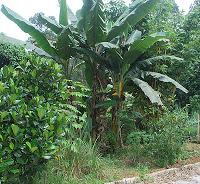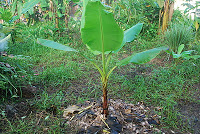 Over the course of 3 years, I have learnt a lot about these plants. It is my quest to have every type of this plants that is “local” to Malaysia which is not genetically modified. In my own way, I am trying to preserve our banana heritage so that we all can share in the richness of our “banana culture”.
Over the course of 3 years, I have learnt a lot about these plants. It is my quest to have every type of this plants that is “local” to Malaysia which is not genetically modified. In my own way, I am trying to preserve our banana heritage so that we all can share in the richness of our “banana culture”.
To date, I have the following plants:
- Pisang Abu Bunga
- Pisang Awak
- Pisang Berangan
- Pisang Emas
- Pisang Embun
- Pisang Kapas
- Pisang Kling
- Pisang Lemak Manis
- Pisang Lidi (Rotan)
- Pisang Nangka
- Pisang Raja
- Pisang Rastali (Batik)
- Pisang Telur
- Pisang Udang
I am still looking for Pisang Tanduk and am finding it difficult to obtain. So, if any of you know where I can get them, I would be happy to hear from you.
 Each plant should be planted at least 10 feet apart or approximately 3.5m initially. As each plant will produce a few baby plants before it is harvested, this will enable the small plants to grow without being crowded out of sunlight, nutrition and water, ensuring quality plants. Selective removal of some of this smaller plants will also contribute to the overall quality of this group of plants.
Each plant should be planted at least 10 feet apart or approximately 3.5m initially. As each plant will produce a few baby plants before it is harvested, this will enable the small plants to grow without being crowded out of sunlight, nutrition and water, ensuring quality plants. Selective removal of some of this smaller plants will also contribute to the overall quality of this group of plants.
Soil type and quality is also important for its growth. The pseudostem (batang pisang) has a high water content and this plant requires a lot of water however does not do well in soggy soil. It is important to have soil that retains sufficient moisture for the plant hence it is best to have high organic content in the soil, Continuous composting of the remains from the plant after harvesting is a cost-effective manner of adding organic content as well as fertilizing the plant. To speed up the process of composting, at the farm, I chop of the remains and spread it around the base of the group of plants.
As the plant grows, frequent removal of the old or dried leaves serves a few purposes, amongst them, providing additional matter for composting, preventing the leaves of the older plants from impeding the growth of the younger plants as well ensuring an aesthetically eye-pleasing view. By placing all these organic matter around the base, it keeps the base cool as well as help retain moisture. This process is done at least monthly though I try to do it fortnightly – the number of plants at the farm being the challenge to accomplish this task.
By using these methods, we do not have to water the plants and can just rely on the normal rainfall for watering them.
I also place additional organic fertilizers about 1m away from the base of the group of plants every 3 months to provide additional nutrients for the plants. The distance is important to prevent “root burning” as well as to encourage growth of roots and allow for natural absorption of nutrients by the plants themselves.
 Once the inflorescence has developed, it is important to ensure that ground moisture is sufficient so as to ensure proper development of the inflorescence – the start of the formation of all those lovely bananas. When all the fruits have appeared, it is best to remove the remaining inflorescence so as to enable the bananas to receive the fullest nutrition for development. The inflorescence can be eaten although not all of them taste good. Certain species produce inflorescence that are not bitter and have a creamy and slightly sweet taste that can be consumed either raw, blanched or cooked. Amongst the species are pisang abu batu, abu bunga and awak.
Once the inflorescence has developed, it is important to ensure that ground moisture is sufficient so as to ensure proper development of the inflorescence – the start of the formation of all those lovely bananas. When all the fruits have appeared, it is best to remove the remaining inflorescence so as to enable the bananas to receive the fullest nutrition for development. The inflorescence can be eaten although not all of them taste good. Certain species produce inflorescence that are not bitter and have a creamy and slightly sweet taste that can be consumed either raw, blanched or cooked. Amongst the species are pisang abu batu, abu bunga and awak.
 The period from the formation of the fruit to when it is ready for harvest varies according to species and growing conditions and can take anywhere from 6 weeks to 10 weeks on average.
The period from the formation of the fruit to when it is ready for harvest varies according to species and growing conditions and can take anywhere from 6 weeks to 10 weeks on average.
 So, how do you know when the bananas are ready to be harvested, especially for the varieties that don’t change the color of their skin? Additionally, I like to harvest the bananas just before it is fully ripened to win the battle against the birds and ants. There are several hints to the readiness for harvest. The first, check the number of leaves left on the plant – there should be 3 or less green leaves left, the remaining already brown or yellow and drying off. The second, look at the end of each fruit, it should already have turned black and the remaining flower petal dried black and fallen off.
So, how do you know when the bananas are ready to be harvested, especially for the varieties that don’t change the color of their skin? Additionally, I like to harvest the bananas just before it is fully ripened to win the battle against the birds and ants. There are several hints to the readiness for harvest. The first, check the number of leaves left on the plant – there should be 3 or less green leaves left, the remaining already brown or yellow and drying off. The second, look at the end of each fruit, it should already have turned black and the remaining flower petal dried black and fallen off.
Once the bananas have been harvested, it can be hung in a cool and airy area to further ripen.
Just remember to chop up the harvested plant and place them around the base of the group of plants so you will have a nice group of plants with the additional benefit of more organic content available for their growth.

 I like to harvest this banana when is it mature and just before the skin starts turning yellow as opposed to letting it ripen on the plant. At this stage, the banana skin is a yellowish-green. Often when it is left to ripen on the plant, it can “overgrow” causing the it to “burst” out of its skin. Additionally, I can avoid my war with the birds. The whole tandan can be hung in the house and watch the skin turn yellow. I find it amazing to watch this transformation.
I like to harvest this banana when is it mature and just before the skin starts turning yellow as opposed to letting it ripen on the plant. At this stage, the banana skin is a yellowish-green. Often when it is left to ripen on the plant, it can “overgrow” causing the it to “burst” out of its skin. Additionally, I can avoid my war with the birds. The whole tandan can be hung in the house and watch the skin turn yellow. I find it amazing to watch this transformation.



























